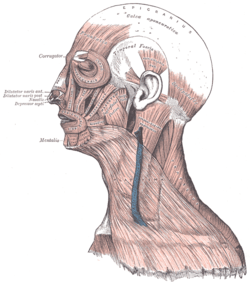Occipitofrontalis muscle
The occipitofrontalis muscle (epicranius muscle) is a muscle which covers parts of the skull. It consists of two parts or bellies: The occipital belly, near the occipital bone, and the frontal belly, near the frontal bone.[1] In humans, the occipitofrontalis only serves for facial expressions.[2]
| Occipitofrontalis | |
|---|---|
 | |
| Details | |
| Origin | Two occipital bellies and two frontal bellies. |
| Insertion | Galea aponeurotica |
| Artery | Frontal belly: supraorbital and supratrochlear arteries Occipital belly: Occipital artery |
| Nerve | Facial nerve |
| Actions | Raises eyebrows, wrinkles forehead |
| Identifiers | |
| Latin | Musculus occipitofrontalis or Musculus epicranii venter frontalis |
| TA | A04.1.03.003 |
| FMA | 9624 |
| Anatomical terms of muscle | |
Some sources consider the occipital and frontal bellies to be two distinct muscles. However, Terminologia Anatomica currently classifies it as a single muscle, and also includes the temporoparietalis muscle as part of the epicranius.
The occipitofrontalis muscle receives blood from several arteries. The frontal belly receives blood from the supraorbital and supratrochlear arteries, while the occipital belly receives blood from the occipital artery.[3] The occipitofrontalis muscle is innervated by the facial nerve.[4]
Course
The occipital belly originates on the lateral two-thirds of the highest nuchal line, and on the mastoid process of the temporal bone. Inserted into the galea aponeurotica, or epicranial aponeurosis, the occipital belly communicates with the frontal belly by an intermediate tendon. From the aponeurosis, the frontal belly is inserted in the fascia of the facial muscles and in the skin above the eyes and nose.[5]
Action
Assisted by the occipital belly, the frontal belly draws the scalp back, which raises the eyebrows and wrinkles the forehead.[4][5]
Evolution
In humans, the occipitofrontalis only serves for facial expressions. In apes, however, the head is not balanced on the vertebral column, and apes therefore need strong muscles that pull back on the skull and prominent supraorbital ridges for the attachment of these muscles.[2]
See also
References
- Drake, Richard L.; Vogl, A. Wayne; Mitchell, Adam W. M. (2010). Gray´s Anatomy for Students (2nd ed.). p. 862. ISBN 978-0-443-06952-9.
- Saladin, Kenneth S. (2003). Anatomy & Physiology: The Unity of Form and Function (3rd ed.). McGraw-Hill. pp. 286–287.
- "Introduction to the Head; Front of Skull and Face/Muscles of the Face". University of Arkansas for Medical Sciences (UAMS). 2007. Retrieved 2008-09-24.
- Drake, Richard L.; Vogl, A. Wayne; Mitchell, Adam W. M. (2010). Gray´s Anatomy for Students (2nd ed.). p. 857. ISBN 978-0-443-06952-9.
- Stone, Robert & Judith (2000). Atlas of skeletal muscles. McGraw-Hill. p. 26. ISBN 978-0-07-290332-4.
External links
- Bérzin F (1989). "Occipitofrontalis muscle: functional analysis revealed by electromyography". Electromyogr Clin Neurophysiol. 29 (6): 355–8. PMID 2689156.